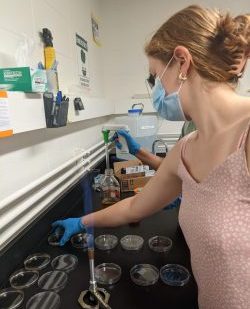To second-year environmental engineering major Emma Kaputa, one good turn deserves another.
As a student in the Syracuse City School District (SCSD), she was chosen for a six-week summer program that allows high schoolers to work as paid interns in Syracuse University physics labs. Kaputa wanted others to have the same positive research experience she had enjoyed, so, after her first year on campus, she returned to her former high school to recruit more students for the program.
The program that left an impression on Kaputa was Syracuse University Research in Physics (SURPh), which aims to inspire students to take up science, technology, engineering and math (STEM) studies and potentially pursue careers in those areas. About two dozen high schoolers have participated in the program over the past two years. They work on cutting-edge research in University physics labs alongside College of Arts and Sciences (A&S) faculty.
Jennifer Ross, professor and chair of physics, leads the program. Assisting her have been Henninger High School science teacher Melanie Pelcher, economics master’s student Devon Lamanna ’23 and Yudaisy Salomón Sargentón, physics department operations specialist. Funding comes from the John Ben Snow Foundation, the National Science Foundation, A&S’s Engaged Humanities Network and the Department of Physics.
Working With Biofilms

The program was devised by Ruell Branch, an SCSD alumnus who is now a dual physics and economics senior at Syracuse. After joining Ross’ research lab, he recognized that other city school students might have the same dream to work in a science lab, while lacking a way to get a foot in that door. Together with Ross, he formulated the program as a way to facilitate the process.

A Say Yes to Syracuse grant recipient, Kaputa had already decided to attend Syracuse when she was selected for the internship. That first summer, she worked in assistant professor Alison Patteson’s biophysics lab exploring biofilms—slimy clusters of bacteria that colonize surfaces. She enjoyed the experience so much that she remained in the lab throughout her first year on campus. Eventually, Kaputa accompanied Patteson, a member of the BioInspired Institute, to SCSD’s Nottingham High School to help recruit the next cohort of interns.
“I learned so much that first year—science skills, poster presentations, networking. I benefitted a lot from the critical thinking that was required. It was fun to go back to the high school and encourage [my former classmates] to apply. I’m really glad to have had that door opened for me and I wanted to extend that to my classmates,” Kaputa says.
A Published Scientist

Patteson calls Kaputa “a really bright and creative student who has made remarkable progress in our group.” She says the program makes it possible for high schoolers to experience real science scholarship. The work Kaputa and her lab mates did—characterizing the mechanical properties of colonies of bacteria—was published in the American Chemical Society Journal, with Kaputa listed as a co-author.
Kaputa’s continuing work in the lab came with additional opportunities. She presented at the BioInspired Institute’s 2023 annual symposium, winning the Most Social Impact award for her poster about the SURPh program. This semester, she will present about staining biofilms with fluorescence at the Biophysical Society’s annual meeting. She also mentored a new group of high school students in the biofilm lab.
Opening Doors

“One of the program’s main goals is to open doors for people who might not otherwise get into science, so it was exciting for me to mentor other women in STEM,” Kaputa says. “I enjoyed being able to show them that there is a place for you here and that you can be successful here.”
How does someone majoring in environmental engineering become deeply involved in physics research?
“There is a lot of physics in engineering,” Kaputa says. “In the coming decades, being at the intersection of these fields will be critical to finding solutions to issues like climate change. I’m hopeful that having a background in multiple fields will give me a unique and useful perspective. It’s exciting to be at the forefront. Life sciences blended with math and physics-biophysics is everything I love.”
It’s important that the interns are compensated, Kaputa says. “This being a paid position is a reason why someone might be able to do summer research. In some families, high schoolers are responsible for providing income, so they need to work over the summer. An unpaid role could be a huge barrier. Adding the paid internship element makes this a lot more accessible, and I think that’s amazing,” she says.
Her advice for others contemplating a science lab internship at Syracuse: “When opportunity knocks, answer. Put yourself out there and show up both physically and mentally. And when given the chance, remember to thank the community that helped get you there, and try to provide the same opportunity to others,” Kaputa says.
-by Diane Stirling
